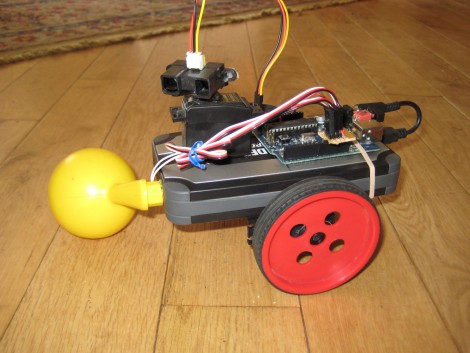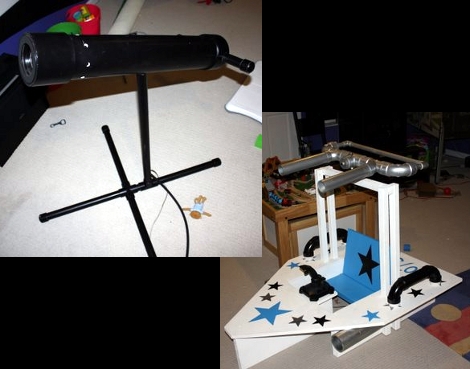[Oneironaut] is back at it again, churning out yet another great hack in this long-distance night vision build. This isn’t the first time we’ve seen him build a night vision device, you may remember the monocle he put together using the view finder from an old camcorder. This time around he’ll give you look at distant object by using a laser instead of LEDs. He pulled an IR laser diode out of an old CD burner, then used a lens to spread out the dot in order to illuminate a larger area. A standard rifle scope is used as the optics, along with a security camera which can detect the infrared light. As always, he’s done a fantastic job with the images and the write-up. You’ll find his overview video embedded after the break.
ir245 Articles
The Wandering Arduinobot

You almost have to love this Arduino based robot just because of the wheels and third leg support. Look closely, do you recognize them? Yep, they’re Capsela parts! That’s a blast from the past and we wonder why we don’t see the strange building toys of yore used in more hacks?
But we digress, this little bugger guy uses continuous rotation servos for locomotion. Perched atop the body is a third servo which scans an IR range finder back and forth to look out for obstacles in its path. The body itself is a Black and Decker rechargeable battery pack called Pocket Power which includes a USB port for a regulated 5V supply. One thing’s for sure, this little guy is fantastic at avoiding pizza and beer… you’ll just have to see for yourself after the break.
IR-controlled Musical Alarm Clock

Forum user [Frank] shared with us his recent project, a musical alarm clock. More than just a simple alarm clock, his creation allows the user to load music onto a micro SD card, has alarm settings for each day of the week, and best of all, can be controlled using an IR remote. He uses a Teensy++ to control most of the clock’s functions including the display, delegating the time keeping to a DS1307 real-time clock. All of the audio playback is handled by a separate music decoder mounted on a breakout board.
His Instructables writeup is extremely detailed, with tons of annotations, pictures, diagrams, and source code available. He walks through each step in detail, making this a great learning guide for others looking to start in on AVR programming.
His final presentation is a great lesson in recycling, though unfortunately a bit lackluster, as the clock is packaged in an old SparkFun cardboard box. He does mention that there were some time constraints towards the end, which may explain this choice – it would be nice to see a revised version of this clock packaged in a nice plexi case.
Kinect Home Theater Control

[Harishankar] has posted a video on his blog demonstrating the ability to control devices using the Microsoft Kinect sensor via IR. While controlling devices with Kinect is nothing new, he is doing something a little different than you have seen before. The Kinect directly interfaces with his Mac Mini and tracks his movements via OpenNI. These movements are then compared to a list of predefined gestures, which have been mapped to specific IR functions for controlling his home theater.
Once the gestures have been acknowledged, they are then relayed from the Mac via a USB-UIRT to various home theater components. While there are not a lot of details fleshed out in the blog post, [Harishankar] says he will gladly forward his code to you if you request it via email.
Thanks to [Peter] for the tip.
Triggering A DSLR Shutter With An Audio Clip

Apparently Pentax DSLR cameras have a remote shutter option that used infrared signals. [Pies for you] gathered up several different hacks and built a method of triggering the camera using custom audio. He put together the dongle above, just a headphone extension cord and two IR LEDs, which plugs into the headphone jack of any audio device like an iPod or an Android phone. When you play back a file the audio signals drive the IR LEDs. This is completely worthless unless you craft your own audio file using the correct frequency, duty cycle, and bit encoding. [Pies for you] did just that and got things up and running. Looks like the system doesn’t do so well with MP3 compression, but take a look at the waveform analysis that he posted and then make sure you’re using a lossless format.
Building Infra Red Light Sources With Regular Lights

[Oneironaut] sent us another IR hack. This time it is a writeup on the best ways to create IR light sources from regular lights. Since normal flashlight bulbs emit a broad enough spectrum to include visible light and IR light, this basically comes down to filtering. [Oneironaut] explores different light sources and different materials in depth, along with great pictures to show his results. This is a great resource if you’re needing to do some night vision for cheap.
Video Game Installations For Kids’ Parties

Why won’t someone think of the children?! Actually, some of the best hacks come from entertaining the little ones. Take [Piles of Spam’s] two video game builds. The first is a telescope-based controller that is used to shoot virtual cannon balls at a projection of a pirate ship. The second is a two-player cooperative game where one player drives and the other shoots. Both of them use a projector to display the playing field, an IR laser for targeting, and an NTSC camera to pick up the location of the laser dot. This works really well, thanks to the quality of the physical builds, and great audio and video on the game side of things. See for yourself in the clips after the break.
A couple of posts into the thread [Piles of Spam] talks about laser intensity. He wanted to make sure that there wouldn’t be a room full of half-blind five year olds thanks to the targeting system. Continue reading “Video Game Installations For Kids’ Parties”











